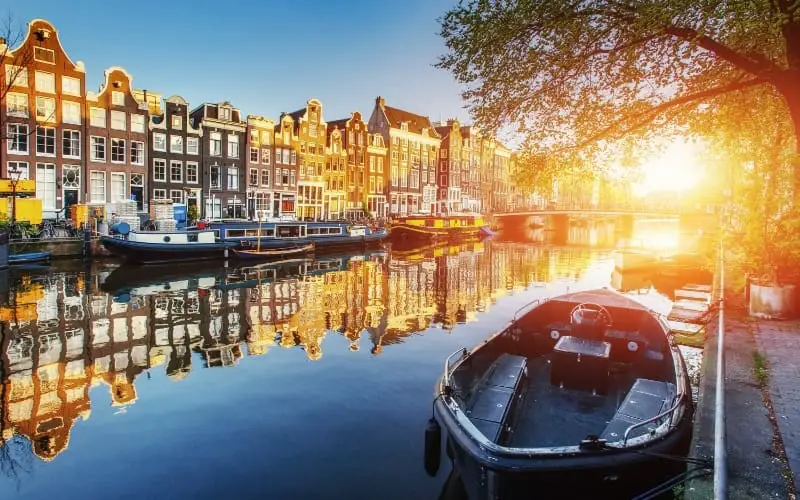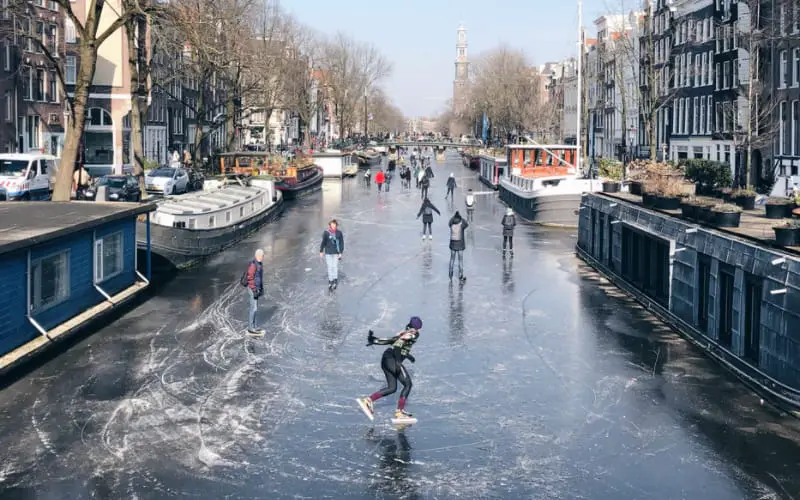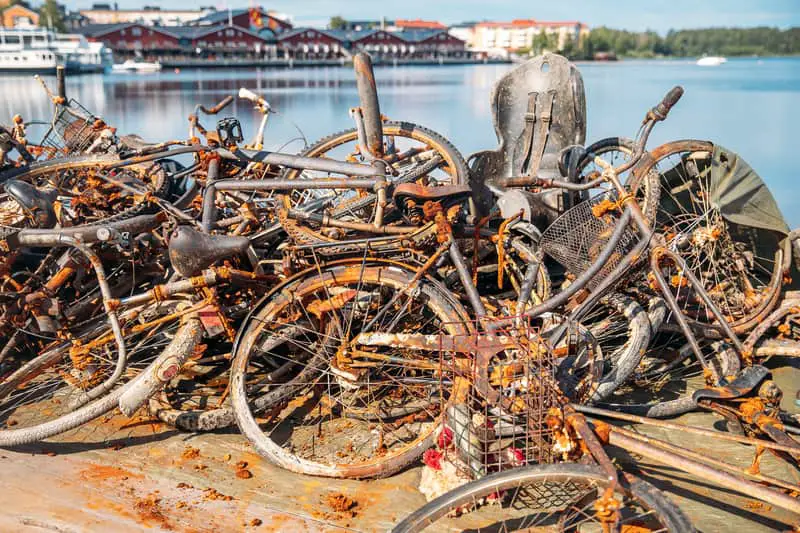

Amsterdam is a world-famous city known for many different things. When people think of the capital of the Netherlands, they’ll immediately think of things like the Red Light District, coffeeshops, the Anne Frank House, museums, architecture, Dam Square, and much more.
But one thing that people will certainly think of when they hear the word Amsterdam is the many canals in the city. Amsterdam isn’t called “Venice of the north” for no reason. These beautiful canals are definitely one of the symbols of the city and have even been on the UNESCO World Heritage List since 1 August 2010.
Millions of photos of these canals are taken every year, and all year round, tour boats filled with tourists come and go. The Amsterdam canals have something magical about them and attract millions of tourists every year, from both inland and abroad.
This beautiful waterway system has existed for many centuries and has a long and rich history. The Amsterdam canals will always stay mysterious, which raises many questions. That’s why I'm going to tell you the 13 best “Amsterdam canals facts” in this blog!
The oldest canal in Amsterdam is the Oudezijds Voorburgwal, which was built in 1385, making it 636 years old.
The city of Amsterdam was founded around 1270 when a dam was built in the river Amstel. The Oudezijds Voorburgwal is the oldest canal in Amsterdam and was built in 1385, which makes the Oudezijds Voorburgwal 636 years old and, therefore, the oldest canal in Amsterdam.
The canals (Damrak Canal and Rokin Canal) date from the time between 1270 and 1500. At the time, these canals were built as city defense and for water management.
As time progressed, the city of Amsterdam grew, and the canals came to lie within the center of the city. At that point, they no longer served as a defense but as a channel for the transportation of goods.
New city walls were built in the 15th century, as well as new canals surrounding them, which were there to protect the city. As a result, the city continued to expand the waterway network.
At the start of the 16th century, the center of Amsterdam was expanded to accommodate a large number of people. It was then decided that three large new canals should be added.
This project began in 1612 and lasted for 50 years; in that time, the city had now become four times as big. The three new canals were called the Keizersgracht, Herengracht, and Prinsengracht.
After the completion of these three famous canals, Amsterdam had the best waterways system in the world. Something which has made the city an enormous amount of money over the centuries through the trade in goods via water.
Since the 20th century, canals have even been filled in due to a lack of space in order to create space for cars and traffic, causing several canals to disappear.
(Click here to find out why the canals of Amsterdam were built)
The Oudezijds Voorburgwal in the 16th Century:

The city of Amsterdam has a total of 165 canals. This makes it the city with the most canals in the world after Hamburg.
Amsterdam is known worldwide for its beautiful canals running through the city. Because of these many canals, Amsterdam is one of the cities which has the most water.
Amsterdam has 165 canals in total. There were more in the past, but several canals have been filled in over the past 100 years in order to create more space for cars and street traffic. In total, around 70 canals have been filled in, which means that the total number of canals used to be much higher.
Of course, it has been an enormous task to create the total number of 165 canals in Amsterdam, and it has taken many centuries. The first canal in Amsterdam was built in 1385, which makes it more than 636 years old.
The total length of all 165 canals in Amsterdam is 75 kilometers (46 miles). The longest canal in Amsterdam is the Singelgracht, which has a length of 6.3 kilometers (2.2 miles).
With an astonishing 165 canals in Amsterdam, the total distance of all canals together accounts for a total length of 75 kilometers (46 miles). This makes Amsterdam the Dutch city with the most kilometers worth of canals. The city of Leiden follows in second place at an appropriate distance with a total number of 28 kilometers (17 miles).
Of course, of all these 165 canals, one has to be the longest. This honor goes to the Singelgracht, which is the longest canal in Amsterdam, with a total length of 6.3 kilometers (2.2 miles).
Singelgracht, the longest canal in Amsterdam:

The average depth of the Amsterdam canals is 2.6 meters (8.5 ft.).
It’s difficult to give a precise answer to this question since there are several factors that influence the water level in the Amsterdam canals.
For instance, the water level can be higher after periods of heavy rainfall due to the canals partly serving as drainage in the city, which leads to the canals being less deep during dry periods.
The many sluices in and around Amsterdam also influence the water level of the canals. Boats go in and out through these sluices, but new water from the Ijsselmeer also flows towards the waters of Amsterdam.
As you can see, there are several factors that determine the depth of the Amsterdam canals. That’s why it’s difficult to give an exact number, but it’s better to give an average depth.
The average depth of the Amsterdam canals is 2.6 meters (8.5 ft.), but as mentioned, the water level is sometimes slightly higher than at other times.
In addition, not all canals have exactly the same depth. As such, the busiest canals will probably be deeper than those canals, which allows for less shipping to pass through.
The water quality of the Amsterdam canals is cleaner than ever. This is partly because the sewer no longer ends up in the canals.
In the past, the water from the canals in Amsterdam was extremely dirty. People could even get sick from it. Today, water quality has vastly improved and is better than ever before. As a matter of fact, water quality is measured and monitored every single day.
Amsterdam has also invested a lot of money and energy in improving water quality. In the past, the sewers of all canal houses and houseboats ended up in the canal, but these are now connected to the sewer. In 2017, for instance, the last houseboat was connected to the sewer.
These efforts have paid off, and as mentioned earlier, the water in the Amsterdam canals is cleaner than ever before. However, it still occasionally happens that the sewage system can’t cope with the water after heavy rainfall, which causes the excess water from the sewer system to run into the canals.
In these rare cases, various pumping stations are used, which pump cleaner water from the surrounding lakes through the Amsterdam canals. This way, the canals are, as it were, rinsed clean again.
Keeping the canals clean takes a lot of effort and a lot of money. Every day, special companies are busy removing waste from the canals with a boat. To give an example, 60,000 kilos (132,277 lbs) of plastic are fished from the water every year, as well as about 7,000 dead animals, most of them being ducks.
You can swim in the Amsterdam canals, although it’s not official swimming water. In addition, it’s dangerous to swim in the canals due to shipping. The Amsterdam City Swim is held once a year. Through this, money for a good cause is raised.
As we now know from the previous question, the water in the canals is a lot cleaner today than in the past. 100 years ago, you would absolutely not have been able to swim in the canals, and you would’ve become very ill from doing so.
Nowadays, people swim in the canals during summer, but usually, this is in canals that are a little further from the center. Officially, the canals are not swimming water, and it can be dangerous due to the many boats sailing through the canals.
Nevertheless, it’s a good sign that people are swimming in the canals increasingly more often, as this means that the water quality is still improving. If you still want to cool down on a hot summer day, then paddling might be a better and safer option.
Even though the Amsterdam canals are not official swimming waters, an exception is made once a year for this. The Amsterdam City Swim takes place every year at the end of August. On this day, thousands of people jump into the canals to raise money for a good cause.
You can definitely ice skate on the Amsterdam canals. The last time this happened was in 2021, 2018, and 2012.
Ice skating and the Netherlands are connected to each other in one way or the other. Naturally, the Netherlands has a lot of water, which makes it possible to ice skate in many places, provided it’s freezing, of course.
When it has frozen hard enough for a good amount of time, it’s also possible to ice skate on the Amsterdam canals. However, due to global warming, winters in the Netherlands have become decreasingly cold in recent years. As a result, it’s becoming less and less common for the possibility to ice skate on natural ice in the Netherlands.
The most recent time that the Amsterdam canals could be ice skated on was in 2021. Where normally the tour boats sailed through the canals, now thousands of people skated on the frozen Amsterdam canals.
This winter scene produced beautiful images and even attracted the attention of the international press.

Due to the improved water quality, Amsterdam's canals are filled with fish. The most common types of fish are pike, perch, and zander.
As mentioned earlier in this blog, the water quality of the canals in Amsterdam has improved enormously. This has led to an enormous increase in the number of species of fish in the waters, both in and around the city.
In addition, the Amsterdam waters have supplies from the Amstel River, the Ijsselmeer, and the North Sea Canal (Noordzeekanaal). Via the North Sea Canal, the current even brings salt water to the city. This ensures that in certain parts of the IJ river, there are both fresh and saltwater fish swimming around. As a result, many different types of fish end up in the waters of Amsterdam.
The improved water quality, in combination with the connection with major rivers, has ensured that the fish in Amsterdam are also increasing in size. For instance, fish of more than one meter (3.2 ft.) are regularly caught in the canals.
Most common types of fish found in the Amsterdam canals:
In the past, it was not wise to eat fish caught in the canals, but nowadays, it’s no longer a problem. Due to the excellent water quality, it’s completely fine to eat a delicious pike-perch from the Amsterdam canals.
The Amsterdam canals are very suitable for fishing. This is due to the good fish stock and because there is a lot of water in the city. Because of this, Amsterdam is sometimes called the street fishing capital of the world.
It’s becoming increasingly popular to fish in Amsterdam, and there are a few reasons for this. For instance, the water quality has improved enormously, there are many different fish species in the canals, and there are many good fishing spots to be found.
Because of these reasons, you see an increase in people fishing in the Amsterdam canals and the waters around them. Today, the city even has its own fishing club with more than 10.000 members.
The many bridges over the canals provide good hiding spots for the predatory fish in the canals. This makes the center of Amsterdam a very good place to fish for predatory fish. Amsterdam is therefore referred to by many as the street fishing capital of the world.
Every year, 15.000 bicycles are removed from the Amsterdam canals.
The Netherlands is, of course, the largest cycling country in the world, as it has more bicycles than its inhabitants. Of course, this also applies to Amsterdam, which means that there are around 900.000 bicycles in Amsterdam.
Because of these enormous numbers of bicycles in the city, bicycles often end up in the canals. It’s a huge task for the city of Amsterdam to get all the mess removed from the canals. To achieve this, companies are working on a daily basis to ensure that the canals remain clean.
In total, these companies collect around 15.000 bikes from the Amsterdam canals every year. This is a huge number, and just imagine if these bikes were left there. It would soon become impossible to sail through the canals.
Old rusty bikes that were pulled out of the Amsterdam canals:

Yearly, about 2 to 5 cars end up in the Amsterdam canals.
Amsterdam is, of course, a large city with lots of traffic. Many cars drive and park in the city on a daily basis.
Because of this, it may happen that someone forgets to use the handbrake, for example, causing the car to fall into a canal. However, these things rarely happen on an annual basis. To get an idea, about 2 to 5 cars fall into the Amsterdam canals every year, but exact figures are not known, however.
On average, 18 bodies are found every year in the Amsterdam canals. In most cases, it’s due to an accident and not because of a crime.
Due to the number of canals in Amsterdam, the chance that someone falls into the water is quite high. As a result, about 18 bodies are found every year in the canals of Amsterdam.
In most cases, it concerns male victims. The main reason is that drunk men fall into the canal while urinating, after which they drown. There are only a few cases where it’s to do with a crime.
The canals of Amsterdam are cleaned by boats with special cranes that allow them to remove the dirt from the water.
Amsterdam is a huge city where a lot is happening. It’s, therefore not surprising that a lot of trash ends up in the canals. To get all this mess out of the canals, there are special companies that specialize in this.
These companies are working to clean the canals on a daily basis. This happens with ships that have special cranes on them. These cranes grab the dirt from the bottom of the canal and throw it on the boat.
For the smaller waste, there are boats on which people stand with landing nets to remove the small waste that floats on the water surface from the canals. For instance, 60.000 kilos (132.277 lbs) of plastic are fished from the water every year, as well as some 7.000 dead animals, most of them being ducks.
MORE FACTS ABOUT THE NETHERLANDS!
Do you like facts? Then please check out our other articles with interesting facts about the Netherlands!
- 19 Interesting Dutch Windmill Facts (Fully Explained)
- 54 Interesting Facts About The Netherlands (Fully Explained)
- 45 Interesting Facts About Amsterdam (Fully Explained)
- 15 Interesting Facts About Dutch Food (Fully Explained)
- 38 Interesting Facts About Utrecht (Facts Fully Explained)
- 52 Amazing Facts About Rotterdam (Facts Fully Explained)
- 30 Facts About Sports In The Netherlands (Find Out Now)
- 46 Fascinating Facts About Dutch History (Find Out Now)
Hopefully, by reading these 13 best “Amsterdam Canals Facts” you’ve learned loads of new things about Amsterdam, the beautiful capital of the Netherlands.
For example, you now know how old the oldest canal is, how many canals there are in Amsterdam, whether there are fish swimming in the canals, and how many bicycles are removed from the canals every year.